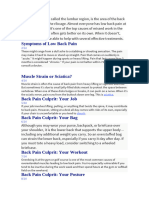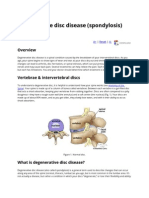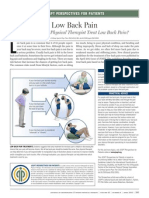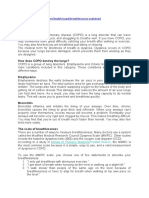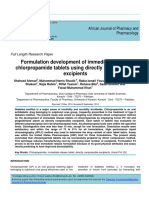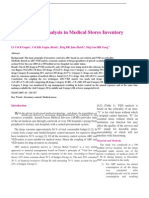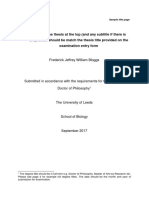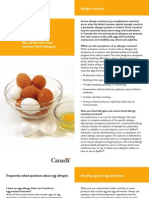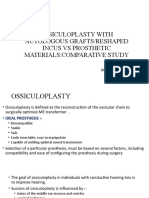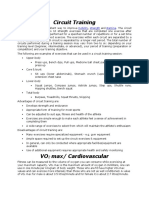0 ratings0% found this document useful (0 votes)
36 viewsFrozen Shoulder
Frozen Shoulder
Uploaded by
RatnaPrasadNalamFrozen shoulder, also known as adhesive capsulitis, is a condition characterized by pain and stiffness in the shoulder that worsens over time until movement becomes very limited. It involves thickening and inflammation of the shoulder capsule tissue. There are three stages - freezing, frozen, and thawing - as the condition progresses and eventually improves, usually within a year with physical therapy but sometimes taking two years or longer to fully recover. Risk factors include age over 50, female sex, diabetes, and previous shoulder injury or surgery.
Copyright:
© All Rights Reserved
Available Formats
Download as PPTX, PDF, TXT or read online from Scribd
Frozen Shoulder
Frozen Shoulder
Uploaded by
RatnaPrasadNalam0 ratings0% found this document useful (0 votes)
36 views16 pagesFrozen shoulder, also known as adhesive capsulitis, is a condition characterized by pain and stiffness in the shoulder that worsens over time until movement becomes very limited. It involves thickening and inflammation of the shoulder capsule tissue. There are three stages - freezing, frozen, and thawing - as the condition progresses and eventually improves, usually within a year with physical therapy but sometimes taking two years or longer to fully recover. Risk factors include age over 50, female sex, diabetes, and previous shoulder injury or surgery.
Original Title
FROZEN SHOULDER
Copyright
© © All Rights Reserved
Available Formats
PPTX, PDF, TXT or read online from Scribd
Share this document
Did you find this document useful?
Is this content inappropriate?
Frozen shoulder, also known as adhesive capsulitis, is a condition characterized by pain and stiffness in the shoulder that worsens over time until movement becomes very limited. It involves thickening and inflammation of the shoulder capsule tissue. There are three stages - freezing, frozen, and thawing - as the condition progresses and eventually improves, usually within a year with physical therapy but sometimes taking two years or longer to fully recover. Risk factors include age over 50, female sex, diabetes, and previous shoulder injury or surgery.
Copyright:
© All Rights Reserved
Available Formats
Download as PPTX, PDF, TXT or read online from Scribd
Download as pptx, pdf, or txt
0 ratings0% found this document useful (0 votes)
36 views16 pagesFrozen Shoulder
Frozen Shoulder
Uploaded by
RatnaPrasadNalamFrozen shoulder, also known as adhesive capsulitis, is a condition characterized by pain and stiffness in the shoulder that worsens over time until movement becomes very limited. It involves thickening and inflammation of the shoulder capsule tissue. There are three stages - freezing, frozen, and thawing - as the condition progresses and eventually improves, usually within a year with physical therapy but sometimes taking two years or longer to fully recover. Risk factors include age over 50, female sex, diabetes, and previous shoulder injury or surgery.
Copyright:
© All Rights Reserved
Available Formats
Download as PPTX, PDF, TXT or read online from Scribd
Download as pptx, pdf, or txt
You are on page 1of 16
FROZEN SHOULDER
What’s Frozen Shoulder?
It’s pain and stiffness in your shoulder
that happens slowly. It can worsen until
your shoulder seems “frozen” in one
position. Your doctor might call it
“adhesive capsulitis.” Although it may
take as much as a few years to get
completely better, it can improve long
before then, especially if you do physical
therapy to help with recovery.
Causes
Doctors don’t know exactly what causes it, though
some things make you more likely to have it. For
example, it can happen if you can’t move your
shoulder very well because of an injury or surgery,
or if you have diabetes, which can worsen
symptoms and make them last longer. Thyroid
problems, Parkinson’s disease, heart disease, and
certain HIV medications also seem to raise your
odds of getting frozen shoulder.
What Happens
Strong connective tissue called the shoulder
capsule surrounds the ball end of your upper
arm bone and holds it to the socket. Frozen
shoulder causes this tissue to get thicker in
parts (adhesions) and inflamed. This may limit
the “synovial” fluid that normally lubricates the
area and prevents rubbing. The result is pain
and stiffness. There are three stages.
Stage 1: Freezing
Over a period of 2 to 9 months, the shoulder
capsule gets more and more inflamed. This
ramps up pain and stiffness, and starts to limit
your range of motion (how well you can use
the joint). And these symptoms often get worse
at night.
Stage 2: Frozen
As you might have guessed, this is when your
shoulder is stiffest and hardest to move. It
usually lasts somewhere between 4 months and
a year. Pain often starts to improve in this
stage. But your range of motion may be so
limited that you find it hard to do basic things
like eat, dress, and go to the bathroom.
Stage 3: Thawing
Your shoulder pain should continue to ease
during this stage, and now you start to regain
some of your range of motion, too. It happens
slowly, taking 6 months to 2 years. In some
cases, you may get back all or almost all of
your strength and mobility.
Who Gets It?
It’s most common if you’re in your 50s or 60s,
and it’s rare for anyone under 40. Women get it
more than men. And if you get frozen shoulder
on one side of your body, you’re up to 30%
more likely to get it on the other side.
Physical Exam
Your doctor will ask you about your symptoms,
injuries, and medical history. Then she’ll check
your shoulder. She’ll move it herself to see
where the pain and stiffness start. This is your
passive range of motion. Then she’ll ask you to
move it yourself. That’s your active range of
motion. At the limit, it may feel like your arm
is stuck. If you have frozen shoulder, your
passive and active range of motion will be less
than normal.
Tests
An “injection test” may help narrow down the
cause of your symptoms. Your doctor gives you
a shot in your arm that dulls the pain. With
most shoulder problems, this gives you a bigger
range of motion, but it won’t change it much if
you have frozen shoulder. Doctors typically
only use imaging tests like X-rays, ultrasounds,
and MRIs to rule out other conditions.
Exercises
Once your frozen shoulder pain starts to ease
up, your doctor might suggest arm exercises. A
physical therapist can give you moves to do as
homework. Take it easy at first. If you “push
through the pain,” you could make things
worse. You’ll likely start with range-of-motion
exercises for a couple of months. After you feel
better, you can safely begin to build strength.
Medicine
NSAIDs (non-steroidal anti-inflammatory
drugs) like aspirin, ibuprofen, and naproxen
may curb pain and swelling. More powerful
drugs called steroids are sometimes injected
directly into the joint. But it can be tricky to get
them into just the right spot, and even these
will only provide temporary relief of your
symptoms.
Hydrodilatation
Your doctor might suggest this method if
physical therapy and medication haven’t
helped. She’ll use pictures of the inside of your
body to guide a shot of fluid into your shoulder
joint. The goal is to stretch out the joint capsule
and give you better range of motion.
Surgery
Your doctor may suggest this, usually in the
“frozen” stage, if nothing else works. There are
two methods, sometimes used together. The
first is manipulation while you’re “asleep”
from general anesthesia. The surgeon moves
the joint until it stretches or even tears the
tissue. The second method, called arthroscopy,
cuts the affected tissue directly. Your surgeon
works through small cuts in your skin, using
special tools.
Recovery
Frozen shoulder gets better for a lot of people
within a year if they do physical therapy and
use pain medicines and steroid shots if needed.
Even without those methods, most people get
better within a couple of years, though if you
have diabetes, it may be harder to recover.
Surgery works pretty well as long as you stick
with your physical therapy afterward to rebuild
and keep up your strength and mobility.
You might also like
- Frozen Shoulder - Adhesive Capsulitis - OrthoInfo - AAOSDocument6 pagesFrozen Shoulder - Adhesive Capsulitis - OrthoInfo - AAOSpempekplgNo ratings yet
- Exercises and Stretches For Ankylosing Spondylitis Back PainDocument7 pagesExercises and Stretches For Ankylosing Spondylitis Back PainBGNo ratings yet
- Frozen Shoulder (Revision)Document6 pagesFrozen Shoulder (Revision)Atet KurniadiNo ratings yet
- Frozen ShoulderDocument6 pagesFrozen ShoulderanumolNo ratings yet
- What Are The Symptoms of Frozen Shoulder?Document3 pagesWhat Are The Symptoms of Frozen Shoulder?Georgij VeshoskiNo ratings yet
- Frozen ShoulderDocument5 pagesFrozen ShoulderRodrigoNo ratings yet
- Patient Education - Frozen Shoulder (Beyond The Basics) - UpToDateDocument7 pagesPatient Education - Frozen Shoulder (Beyond The Basics) - UpToDateSylvia GraceNo ratings yet
- InjuriesDocument31 pagesInjuriesPranjali MathurNo ratings yet
- Back Pain Basics WebDocument17 pagesBack Pain Basics WebAnonymous GzRz4H50FNo ratings yet
- Frozen Shoulder: Information For YouDocument8 pagesFrozen Shoulder: Information For YouCentaur Archer100% (2)
- Rehabilitation Exercises For Frozen ShoulderDocument5 pagesRehabilitation Exercises For Frozen ShoulderRajorshi MishraNo ratings yet
- The Low BackDocument15 pagesThe Low BackColoNo ratings yet
- Leave Muscle and Back PainDocument12 pagesLeave Muscle and Back PainBackpainGone067% (3)
- Hip Specialist NYCDocument7 pagesHip Specialist NYCLev KalikaNo ratings yet
- Basics: Common QuestionsDocument17 pagesBasics: Common QuestionsCutisanserinaNo ratings yet
- A Patient's Guide To Adhesive CapsulitisDocument6 pagesA Patient's Guide To Adhesive Capsulitisamal sehat100% (1)
- Anky Losing Fact Sheet 2011Document6 pagesAnky Losing Fact Sheet 2011Irwan Santos ONo ratings yet
- Frozen ShoulderDocument4 pagesFrozen ShoulderFirza OktavianiNo ratings yet
- North American Spine Society Public Education SeriesDocument12 pagesNorth American Spine Society Public Education Serieseryoktadiputra565No ratings yet
- Understanding Ankylosing Spondylitis: Stiffness and Pain in The Lower BackDocument9 pagesUnderstanding Ankylosing Spondylitis: Stiffness and Pain in The Lower BackIonut ManNo ratings yet
- Frozen Shoulder - Adhesive CapsulitisDocument8 pagesFrozen Shoulder - Adhesive CapsulitisfriskaNo ratings yet
- Back PainDocument22 pagesBack PainmelissaparkonNo ratings yet
- Physical Effects of StrokeDocument6 pagesPhysical Effects of StrokeZain StoreNo ratings yet
- The Breakthrough Back Pain Healing and Relief Plan: The book that unlocked the secrets of back pain care, sciatica pain relief naturally via diet, exercises & understanding the mind-body connectionFrom EverandThe Breakthrough Back Pain Healing and Relief Plan: The book that unlocked the secrets of back pain care, sciatica pain relief naturally via diet, exercises & understanding the mind-body connectionNo ratings yet
- What Are The Physical Effects of Stroke?Document8 pagesWhat Are The Physical Effects of Stroke?Arlind LleshiNo ratings yet
- Yoga for Anti-Aging: Secret to a Younger and Healthier Looking You - Yoga for Everybody #4From EverandYoga for Anti-Aging: Secret to a Younger and Healthier Looking You - Yoga for Everybody #4No ratings yet
- Si J Patient GuideDocument7 pagesSi J Patient Guidemtripcev_635029270No ratings yet
- What Causes Sciatica - Back Pain ReliefDocument23 pagesWhat Causes Sciatica - Back Pain ReliefDana GaliceanuNo ratings yet
- SpasticityDocument13 pagesSpasticityVeny AjrinaNo ratings yet
- Pain After Stroke: Spasticity and ContracturesDocument8 pagesPain After Stroke: Spasticity and ContracturesAnonymous RsvDbUVZHNo ratings yet
- Pain After Stroke: Spasticity and ContracturesDocument8 pagesPain After Stroke: Spasticity and ContracturesRhoneil DejarmeNo ratings yet
- Don't Let The Pain Con Trol Your LifeDocument5 pagesDon't Let The Pain Con Trol Your Lifejunieth ANo ratings yet
- Readers Digest Pain E-ZineDocument10 pagesReaders Digest Pain E-Zineshobu_iujNo ratings yet
- Exercise Frozen ShoulderDocument2 pagesExercise Frozen ShoulderAnonymous D15WroNo ratings yet
- Overuse Injuries: Impact ForcesDocument4 pagesOveruse Injuries: Impact Forcessecret 22No ratings yet
- Herniated Disk (Princess)Document4 pagesHerniated Disk (Princess)Evangel PaduaNo ratings yet
- Ankylosing SpondylitisDocument6 pagesAnkylosing SpondylitisAnonymous VzFhQ3iNo ratings yet
- Back Pain: Back Pain Treatment: Back Pain Relief: How To Heal Back ProblemsFrom EverandBack Pain: Back Pain Treatment: Back Pain Relief: How To Heal Back ProblemsNo ratings yet
- Spondylosis (Degenerative Disc Disease)Document7 pagesSpondylosis (Degenerative Disc Disease)SaifulAnamNo ratings yet
- Backbone PainDocument4 pagesBackbone PainENTREPRENEUR 8211No ratings yet
- Best Physical Therapy Methods For Treating Shoulder Pain & InjuriesDocument1 pageBest Physical Therapy Methods For Treating Shoulder Pain & Injuriesaidoojeffery260No ratings yet
- Sciatica Pain During Pregnancy: Natural Ways To Get Over It With Physio Active SGDocument11 pagesSciatica Pain During Pregnancy: Natural Ways To Get Over It With Physio Active SGPhysioActiveSG100% (1)
- Frozen Shoulder Exercise GuideDocument58 pagesFrozen Shoulder Exercise GuideChaman Lal KarotiaNo ratings yet
- Sports TreatmentDocument84 pagesSports TreatmentBASAVARAJNo ratings yet
- Adhesive Capsulitis or Frozen SholderDocument24 pagesAdhesive Capsulitis or Frozen Sholdersanalcrazy100% (1)
- Symptoms of Ankylosing Spondylitis KPDocument3 pagesSymptoms of Ankylosing Spondylitis KPlabuansquaremedicalNo ratings yet
- Cure Your Back Pain - The Complete Guide to Getting Rid Of Your Back PainFrom EverandCure Your Back Pain - The Complete Guide to Getting Rid Of Your Back PainNo ratings yet
- Englsih Multimodal EssayDocument6 pagesEnglsih Multimodal Essayapi-667816610No ratings yet
- The Complete Guide To Pole Dancing Muscle Injuries Love Pole KissesDocument12 pagesThe Complete Guide To Pole Dancing Muscle Injuries Love Pole KissesThaís HélèneNo ratings yet
- Apr2012 PerspectivesDocument1 pageApr2012 PerspectivesPaul MillerickNo ratings yet
- Balance Problems After Stroke PDFDocument8 pagesBalance Problems After Stroke PDFAli MahammedNo ratings yet
- What Is LBP ?Document5 pagesWhat Is LBP ?Golam KibriaNo ratings yet
- Neck PainDocument8 pagesNeck Painvipra ayurvedaNo ratings yet
- Osteoarthritis: CausesDocument5 pagesOsteoarthritis: CausesYahya i.nNo ratings yet
- Does Back Pain Go Away? 10 Answers To The Most Acute Back Pain IssuesFrom EverandDoes Back Pain Go Away? 10 Answers To The Most Acute Back Pain IssuesNo ratings yet
- Frozen Shoulder FinalDocument3 pagesFrozen Shoulder FinalRatnaPrasadNalamNo ratings yet
- Methods of Transfer of Property' - Tax' ConsequencesDocument4 pagesMethods of Transfer of Property' - Tax' ConsequencesRatnaPrasadNalamNo ratings yet
- Shoulder Pain and Common Shoulder ProblemsDocument14 pagesShoulder Pain and Common Shoulder ProblemsRatnaPrasadNalamNo ratings yet
- Early Signs of ParkinsonDocument9 pagesEarly Signs of ParkinsonRatnaPrasadNalamNo ratings yet
- Copd & DyspneaDocument2 pagesCopd & DyspneaRatnaPrasadNalamNo ratings yet
- What Is A StrokeDocument10 pagesWhat Is A StrokeRatnaPrasadNalamNo ratings yet
- Dyskinesia FACT SHEETDocument2 pagesDyskinesia FACT SHEETRatnaPrasadNalamNo ratings yet
- Home Remedies For HypothyroidismDocument2 pagesHome Remedies For HypothyroidismRatnaPrasadNalamNo ratings yet
- What Tests Are Done To Diagnose Kidney StonesDocument3 pagesWhat Tests Are Done To Diagnose Kidney StonesRatnaPrasadNalamNo ratings yet
- To Get Rid of Trapped GasDocument2 pagesTo Get Rid of Trapped GasRatnaPrasadNalamNo ratings yet
- Eye Symptoms and Vision ProblemsDocument6 pagesEye Symptoms and Vision ProblemsRatnaPrasadNalamNo ratings yet
- Cholesterol Testing and The Lipid Panel - Treatment Options For Abnormal Lipid LevelsDocument6 pagesCholesterol Testing and The Lipid Panel - Treatment Options For Abnormal Lipid LevelsRatnaPrasadNalamNo ratings yet
- How To Relieve Gas - Easy Methods and RemediesDocument11 pagesHow To Relieve Gas - Easy Methods and RemediesRatnaPrasadNalamNo ratings yet
- Eye Mistakes You Might Be MakingDocument3 pagesEye Mistakes You Might Be MakingRatnaPrasadNalamNo ratings yet
- Eye InfectionsDocument9 pagesEye InfectionsRatnaPrasadNalamNo ratings yet
- 23 Facts About Your EyesDocument6 pages23 Facts About Your EyesRatnaPrasadNalamNo ratings yet
- Diabetes-The Differences Between Types 1 and 2Document6 pagesDiabetes-The Differences Between Types 1 and 2RatnaPrasadNalamNo ratings yet
- Build Resilience To Better Handle DiabetesDocument1 pageBuild Resilience To Better Handle DiabetesRatnaPrasadNalamNo ratings yet
- Ralph Slater Hypnotism and Self HypnosisDocument83 pagesRalph Slater Hypnotism and Self HypnosisNguyen Hong Ha100% (2)
- Case Discussion StrokeDocument22 pagesCase Discussion StrokeKevin GarciaNo ratings yet
- Bag TechniqueDocument40 pagesBag TechniquemesdejenNo ratings yet
- GNIPST Bulletin 40.2Document22 pagesGNIPST Bulletin 40.2Gnipst BulletinNo ratings yet
- Legal DraftingDocument22 pagesLegal DraftingThanh Hòa Lê KhánhNo ratings yet
- Mini Thesis Schoolwide Enrichment Model (SEM) Water Spinach JuiceDocument13 pagesMini Thesis Schoolwide Enrichment Model (SEM) Water Spinach JuiceAhmad AmarNo ratings yet
- Sample UK English EQ-5D-5L Paper Self Complete v1 PDFDocument3 pagesSample UK English EQ-5D-5L Paper Self Complete v1 PDFCostea ElenaNo ratings yet
- Psych Units 11-13 Cheat SheetDocument1 pagePsych Units 11-13 Cheat SheetTalia ShumanNo ratings yet
- Gurvinder Kalra,: MD, DPM Psychiatrist Lrh-MhsDocument16 pagesGurvinder Kalra,: MD, DPM Psychiatrist Lrh-MhsGurvinder KalraNo ratings yet
- Dorothy Johnson's TheoryDocument23 pagesDorothy Johnson's Theoryarielledy0405No ratings yet
- WelchAllyn Vital Signs - User ManualDocument106 pagesWelchAllyn Vital Signs - User Manualhassan niazyNo ratings yet
- Formulation Development of Immediate Release Chlorpropamide Tablets Using Directly Compressible ExcipientsDocument5 pagesFormulation Development of Immediate Release Chlorpropamide Tablets Using Directly Compressible ExcipientsNanda RiandaNo ratings yet
- ABC Ved Combined AnalysisDocument7 pagesABC Ved Combined AnalysisanimeshionNo ratings yet
- Sample Title Page and Spine Sept2017Document5 pagesSample Title Page and Spine Sept2017MustafaNo ratings yet
- An Alternative Treatment Approach To Gingival Recession: Gingiva-Colored Partial Porcelain Veneers: A Clinical ReportDocument22 pagesAn Alternative Treatment Approach To Gingival Recession: Gingiva-Colored Partial Porcelain Veneers: A Clinical ReportSoumya Promod100% (1)
- EGA Factsheet 01Document1 pageEGA Factsheet 01Rajeeb Chandra ShahaNo ratings yet
- OKfSHL45V9T Original 29Document1 pageOKfSHL45V9T Original 29jihad9j999No ratings yet
- Doctor Mi Kay Khau Nandini DhargalkarDocument51 pagesDoctor Mi Kay Khau Nandini Dhargalkarabmopalhvac0% (1)
- NCP Deficient KnowlwdgeDocument2 pagesNCP Deficient KnowlwdgeMICHELLE MALLARENo ratings yet
- Egg Allergy - Alternate Names For Egg Ingredients in Food Ingredient ListsDocument4 pagesEgg Allergy - Alternate Names For Egg Ingredients in Food Ingredient Listsmelissascheichl416No ratings yet
- Wos-Collection EX12Document169 pagesWos-Collection EX12Chandrasekar MuthukumarNo ratings yet
- Effect of Benson Relaxation On The Intensity of Spinal Anesthesia-Induced Pain After Elective General and Urologic SurgeryDocument9 pagesEffect of Benson Relaxation On The Intensity of Spinal Anesthesia-Induced Pain After Elective General and Urologic Surgeryeny_sumaini65No ratings yet
- AntihistaminesDocument36 pagesAntihistaminesAli ElattarNo ratings yet
- Antibody DeamidationDocument17 pagesAntibody DeamidationArpit ThumarNo ratings yet
- 04.06.2018 - 5 - M. Zerafa - Fluid and Electrolyte PhysiologyDocument20 pages04.06.2018 - 5 - M. Zerafa - Fluid and Electrolyte PhysiologyPhilippe KinnaerNo ratings yet
- CLTI Guidelines ESVS SVS WFVSDocument142 pagesCLTI Guidelines ESVS SVS WFVSAhmed Elmallah100% (1)
- Ossiculoplasty With Autologous Grafts/Reshaped Incus Vs Prosthetic Materials:Comparative StudyDocument33 pagesOssiculoplasty With Autologous Grafts/Reshaped Incus Vs Prosthetic Materials:Comparative StudyPushkar Raaj PatidarNo ratings yet
- Visa-G - With Scoring (English)Document3 pagesVisa-G - With Scoring (English)Naily FaizonNo ratings yet
- Anaphylaxis Reaction Caused by Honey Based Enema A Case ReportDocument3 pagesAnaphylaxis Reaction Caused by Honey Based Enema A Case ReportEditor IJTSRDNo ratings yet
- Circuit Training HandoutsDocument4 pagesCircuit Training HandoutsGwyneth Bunda100% (1)











